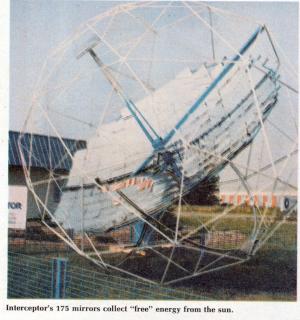1980 - Volume #4, Issue #6, Page #21
[ Sample Stories From This Issue | List of All Stories In This Issue | Print this story
| Read this issue]
Solar Collector Follows The Sun
 |
Designed to produce low cost supplemental heat for hog barns, poultry houses and other agricultural uses, the Solar Interceptor rotates automatically to follow the sun from sunup to sundown. "This sun tracking is east-west oriented to follow the sun's daily path, and is also northsouth oriented to maintain the correct angle each season of the year," explains Bruce Glass, advertising manager.
"We know it works," says Glass. "However, before we get into full production, we want to closely monitor a dozen or so pilot installations so we can refer to concrete data in telling prospects, wherever they might be located, what kind of performance they can expect."
The collector's 175 mirrors are strategically positioned to reflect sunlight to a centrally located watercooled heat exchanger. "This design has the effect of multiplying the warming effect of the sunlight 175 times to produce an amazingly high temperature at the focal point. It's hot enough to create live steam. Thus, it has no trouble in maintaining practical water temperatures in the 180? range," explains Glass. "If the exchanger were dry (containing no circulating water), its temperature would reach 2,000?F on a clear day.
"Because clear sunlight is not constantly present, the unit must be considered supplemental to primary heat sources. Its effectiveness is enhanced by clean air, which allows more energy to reach it. It is more efficient on clear winter days than on hazy summer days. The energy collected depends entirely on the amount and intensity of sunlight reflected from the surfaces of the mirros."
Two small electric motors supply the power to keep the mirrors facing the sun. They require about 50 cents worth of electricity per year to operate.
Solar heat collected during the day heats water which, in turn, circulates throughout the building to provide heat during the night. At sunrise, the collector goes back into action, heating up water for another cycle.
Cost of the basic unit, less plumbing inside the building being served by the unit, is right at $5,000. "We figure it has a five to seven year payback," says Glass. "If a hail storm would knock out all 175 mirrors, which is a remote possibility, total replacement cost would only be $125."
Glass notes that the tubular structure is designed to withstand strong winds. And, if the mirrors get dusty, they can be washed off with a garden hose, or wiped off with a cloth.
For more details, contact: FARM SHOW Followup, Cyclone International, P.O. Box 1017, Holland, Mich. 49423 (ph 616 392-5981).

Click here to download page story appeared in.

Click here to read entire issue
To read the rest of this story, download this issue below or click here to register with your account number.




